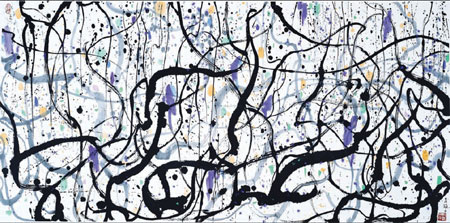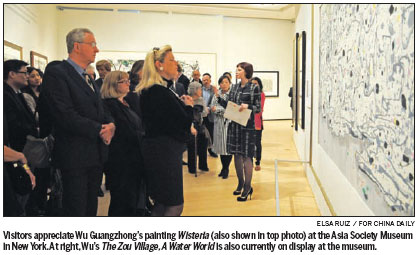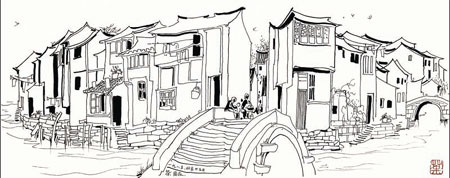A colorful innovator in ink gets Manhattan show
Updated: 2012-06-22 12:46
By Kelly Chung Dawson in New York (China Daily)
|
||||||||




Wu Guanzhong is now considered one of the most influential Chinese artists of the 20th century, but he didn't always enjoy such standing.
During the "cultural revolution" (1966-76), his Western training in oil painting served as a mark against Wu, but it was his return to a Chinese medium in the late 1970s that truly elevated his work. As China opened up to the world and many of its artists turned to the West for inspiration, Wu gravitated to a traditional ink-and-brush style, albeit with a Western twist by using bright colors and playful abstraction.
Now, some of Wu's remarkable pieces are on display at the Asia Society in New York. The exhibition is the result of a fouryear collaboration between the organization and the Shanghai Art Museum, to which the artist donated most of his work before his death in 2010.
Revolutionary Ink: The Paintings of Wu Guanzhong, which runs through Aug 5, is the first US retrospective of the artist's work, with a focus on pieces created between the late 1970s and 2004.
"My father's journey as an artist was always about finding the perfect merger between Eastern art and Western art," the artist's son Wu Keyu said in an interview with China Daily. "In his works he tried to represent not only traditional Chinese painting, but he also tried to inject Western ideas and creativity into a Chinese medium."
In remarks at the Asia Society earlier this year, his son described Wu's desire for acceptance in the West.
"He very much wanted to be appreciated and recognized from the Western point of view and perspective," Wu Keyu said. "So this is truly an opportunity. I think that this exhibition is the kind of platform he himself would have been proud in which to showcase his works." Melissa Chiu, director of the Asia Society Museum and co-curator of the exhibition, worked with Wu before his death.
"I had the opportunity to meet him, and I know that he was so proud to have his first ever exhibition in New York," she said in prepared remarks at the opening. "He was very interested in being able to present his works in New York, a cultural capital of the world. And we were of course very interested in him, because he was an artist with an interesting life trajectory."
Calling Wu "one of the most respected and revered artists in China today," Chiu added: "As the title of the exhibition suggests, he really did energize this traditional medium. He had such mastery and he was able to paint on a large scale. His use of bright colors is something that stands in contrast to what we would normally see in traditional ink paintings. And his subject matter - he focused on abstraction, so I think that this focus on wanting to portray a psychological or emotional condition is quite remarkable for an ink painter."
The exhibition was an unusually close "curatorial partnership" between the Asia Society and the Shanghai museum, Chiu said, contrasting it with shows in which a US museum borrows objects from a Chinese cultural institution and produces the event on its own.
Teng Junjie, artistic director of the Shanghai Municipal Administration of Culture, also spoke at the Asia Society.
"Culture can be genuinely outstanding for its quality, and for that reason I admire the art of Wu Guanzhong," he said. Teng was accompanied by two Shanghai Art Museum officials�Cexecutive director Li Lei and curator Lu Huan.
The exhibition is split into three sections: Landscape, consisting of paintings from the late 1980s and 1990s, depicting scenes of nature in both vertical and horizontal format; Architecture, in which Wu painted grand homes, towns and other manmade structures; and Abstraction, an area the artist delved into during his later years, mostly after 1990.
The artist once wrote: "I want to express the transformations in space and time that occur in my mind. The many forms I see with my eyes inspire the unpredictable transformations that I haven't yet seen."
Of his move into ink-andbrush painting, he wrote: "I used Eastern rhythms in the absorption of Western form and color, like a snake swallowing an elephant. Sometimes I felt I couldn't gulp it all down and I switched to using [Chinese] ink. As of today in my explorations I still shift between oil and ink.
"Oil paint and ink are two blades of the same pair of scissors used to cut the pattern for a whole new suit. To nationalize oil painting and to modernize Chinese painting: In my view these are two sides of the same face."
Wu Keyu recalled that his father dissuaded him from pursuing art, because at the time Chinese artists faced a discouraging atmosphere, he said.
"But my father was extremely passionate about art, and his life was about his work," the son said. "That passion never
stopped. And fortunately for him, he lived into a time when China changed, society changed and people's perspectives on art changed. He eventually got the positive support he needed, and he went from someone who was not acknowledged to someone who was respected nationwide for his work.
"I hope that audiences will see his passion and his perseverance through the works on display. I know that New Yorkers will really enjoy the exhibition."
kdawson@chinadailyusa.com

 Relief reaches isolated village
Relief reaches isolated village
 Rainfall poses new threats to quake-hit region
Rainfall poses new threats to quake-hit region
 Funerals begin for Boston bombing victims
Funerals begin for Boston bombing victims
 Quake takeaway from China's Air Force
Quake takeaway from China's Air Force
 Obama celebrates young inventors at science fair
Obama celebrates young inventors at science fair
 Earth Day marked around the world
Earth Day marked around the world
 Volunteer team helping students find sense of normalcy
Volunteer team helping students find sense of normalcy
 Ethnic groups quick to join rescue efforts
Ethnic groups quick to join rescue efforts
Most Viewed
Editor's Picks

|

|

|

|

|

|
Today's Top News
Health new priority for quake zone
Xi meets US top military officer
Japan's boats driven out of Diaoyu
China mulls online shopping legislation
Bird flu death toll rises to 22
Putin appoints new ambassador to China
Japanese ships blocked from Diaoyu Islands
Inspired by Guan, more Chinese pick up golf
US Weekly

|

|






